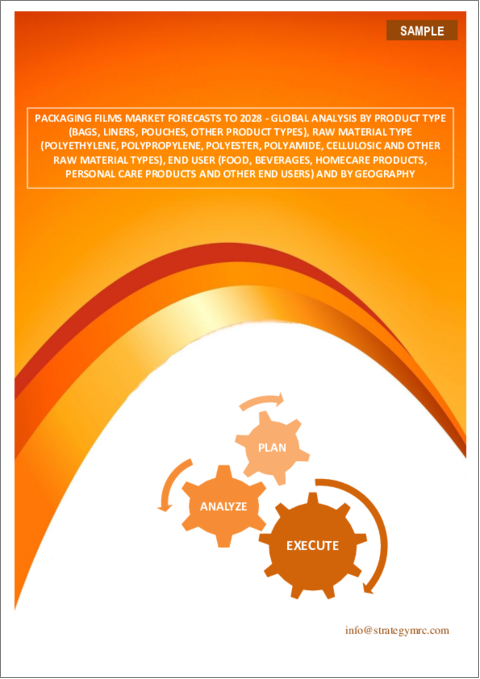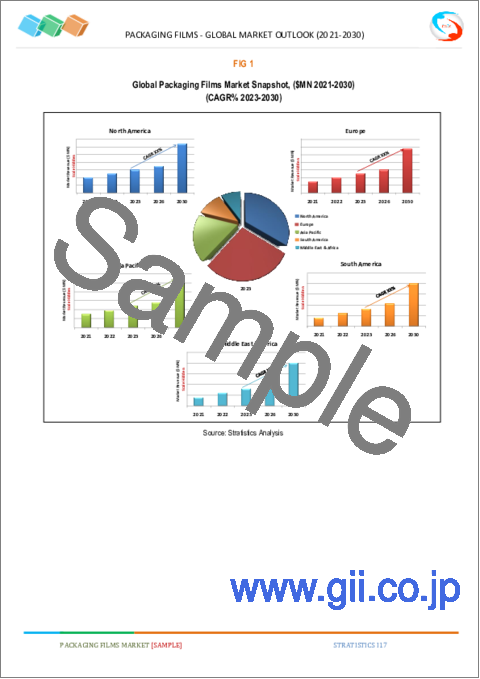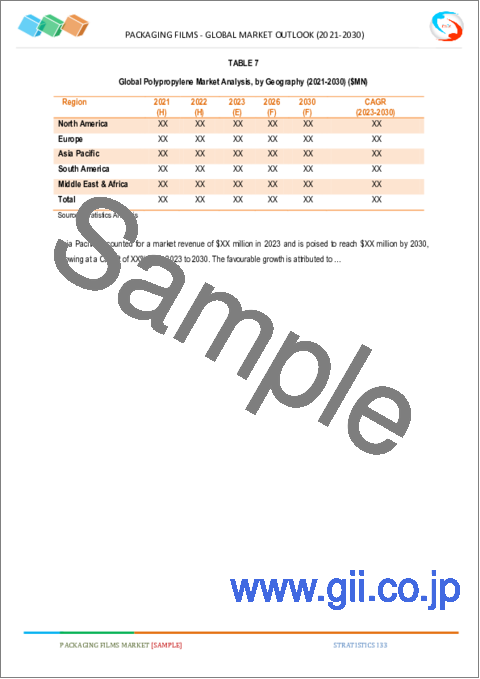|
|
市場調査レポート
商品コード
1284193
包装フィルム市場の2028年までの予測-製品タイプ別、原材料タイプ別、エンドユーザー別、地域別の世界分析Packaging Films Market Forecasts to 2028 - Global Analysis By Product Type, Raw Material Type, End User and By Geography |
||||||
カスタマイズ可能
|
|||||||
| 包装フィルム市場の2028年までの予測-製品タイプ別、原材料タイプ別、エンドユーザー別、地域別の世界分析 |
|
出版日: 2023年06月01日
発行: Stratistics Market Research Consulting
ページ情報: 英文 175+ Pages
納期: 2~3営業日
|
- 全表示
- 概要
- 図表
- 目次
Stratistics MRCによると、包装フィルムの世界市場は、2022年に1,160億米ドルを占め、予測期間中にCAGR 8.2%で成長し、2028年には1,870億米ドルに達すると予測されています。
包装フィルムは、飲食品、ホームケア、パーソナルケア、ヘルスケア、エレクトロニクス、電気製品を生産する産業など、さまざまな産業で使用されています。包装フィルムの需要は、消費財や健康食品の需要の急増に加え、eコマース産業の拡大によって牽引されています。
市場力学:
促進要因:
エンドユーザーセグメントでの幅広い用途が成長を牽引している
包装フィルムの市場は、食品包装フィルムの用途が急速に拡大した結果、大きく拡大しています。これは、硬質包装から軟質包装への移行を後押しするダウンガウジング傾向の高まりに起因しています。包装フィルムの需要は、製品の賞味期限延長や包装材料の廃棄物削減への強い関心に加え、果物、肉、野菜、魚介類などの生鮮食品の包装の人気が高まった結果、増加しました。また、パンデミック後のフードデリバリー分野への投資の増加や、衛生管理のためにフードデリバリーサービスが増加していることも、市場拡大を促進する重要な要因となっています。
抑制要因
原材料価格の変動
市場の拡大は、原材料価格の変動によって妨げられると予想されます。また、プラスチック包装フィルム市場は、他の包装材料との競合に直面すると予想されます。
機会
eコマースビジネスの急成長
COVID-19以降の安全性への懸念の高まりから、包装衛生が再び人気を集めています。さらに、この時期にはeコマースが増加し、衛生的で持続可能な、魅力的で実用的な包装フィルムの需要が高まりました。従来の透明シュリンクフィルムよりも厚みがあるため、耐久性や性能を確保しつつ、荷物の中身が見えない、引き裂き強度が高いなど、その目立たない特性から、ネット注文の急増に伴い、eコマース市場でも包装フィルムの普及が進みました。
脅威
厳しい規制
世界の包装フィルム産業の拡大を阻む主な要因のひとつに、プラスチックの使用を規制する厳しい法律があります。食品包装の増加やリサイクル問題への懸念から、このような法律が施行されました。さらに、リサイクルに関する問題や経年劣化のしやすさなども、市場の成長をさらに低下させる懸念や危険要因となっています。
COVID-19の影響:
COVID-19の大流行により、フィルム包装の需要は大幅に増加しました。オンラインショッピングや食品宅配の増加により、包装フィルムの使用量が増加したため、市場の需要は大幅に増加しました。また、この時期の生産は、eコマースへのシフトが加速した結果、恒常的に頭打ちとなっています。
予測期間中、ポリエチレンセグメントが最大と予想される
予測期間中、最大の市場シェアを占めると予想されるのは、ポリエチレン分野です。ポリエチレンは、世界中で包装フィルムの材料として広く使用されています。フレキシブル包装フィルムへの需要の高まりが、予測期間中にポリエチレンの需要を促進すると予想されます。さらに、飲食品を製造する企業は、ポリエチレン包装フィルムの使用頻度を高めています。ポリエチレン包装フィルムは、より良い保護や長い保存期間に役立つ特別なバリア特性を備えているためです。メーカーは、食品の安全性と鮮度、安全な流通と保管、風雨からの保護を保証するために、より優れたフレキシブル包装フィルムの作成にますます多くの費用を費やしており、これが市場の拡大を促しています。
予測期間中、食品分野のCAGRが最も高くなると予想される
予測期間中、食品分野は大幅な成長を遂げると予想されています。抗菌・抗酸化食品包装に対する消費者ニーズの高まりが、パッケージフィルムの市場成長を後押しすると予想されます。パッケージ内の酸素濃度を下げ、微生物の繁殖を防ぐために、パッケージフィルムメーカーは新しい抗菌・抗酸化食品パッケージの開発に投資しており、これがこの分野の燃料となっています。
最もシェアが高い地域
アジア太平洋地域の包装フィルム市場は、2020年に最も高い収益シェアを獲得し、予想される期間中も最大の市場シェアを維持すると予想されます。中国がアジア太平洋地域の包装フィルム市場で最大のシェアを占めると予想されますが、その主な理由は、大規模な中間層人口、可処分所得の増加、包装食品および医薬品の大きな市場であるためです。同地域の包装フィルム市場は、医薬品生産量の増加により、大きな伸びを示しています。
CAGRが最も高い地域:
予測期間中、欧州は有益な成長を遂げると予想されています。プラスチック欧州協会が発表した報告書によると、2019年には、世界で5,790万トンのプラスチックが生産されました。これは、欧州の16%近い市場シェアに相当します。ドイツはプラスチックのトップ消費国であると指摘されており、欧州で生産されたプラスチックの約4分の1がドイツの消費者によって消費されています。また、スペイン、フランス、イタリアもプラスチック需要が堅調に推移しており、市場拡大に拍車をかけています。
主な発展:
2022年5月、Jindal Poly Films Limited(JFPL)はBrookfield Asset Managementと契約を結び、同社の包装フィルム事業のごく一部を売却しました。同社は、機関投資家パートナー(総称して「ブルックフィールド」)と共に、同事業に2,000カロールインドルピー(2億6,000万米ドル)を投じることを決定しました。
2022年3月、SAES Coated FilmsとRKW Groupは、製品のライフサイクルを通じて高い保護性能を発揮することを目的とした、持続可能な食品包装用のプレミアムパフォーマンスフィルムの開発で提携しました。
当レポートが提供するもの
- 地域レベルおよび国レベルセグメントの市場シェア評価
- 新規参入企業への戦略的提言
- 2020年、2021年、2022年、2025年、2028年の市場データを網羅
- 市場動向(促進要因、抑制要因、機会、脅威、課題、投資機会、推奨事項)
- 市場推定に基づく、主要ビジネスセグメントにおける戦略的提言
- 主要な共通トレンドをマッピングした競合情勢。
- 詳細な戦略、財務、最近の開発状況を含む企業プロファイル
- 最新の技術的進歩をマッピングしたサプライチェーン動向
無料のカスタマイズ提供:
本レポートをご購入いただいたお客様には、以下の無料カスタマイズオプションのいずれかを提供させていただきます:
- 企業プロファイル
- 追加市場プレイヤーの包括的なプロファイリング(最大3社まで)
- 主要プレイヤーのSWOT分析(3社まで)
- 地域別セグメンテーション
- お客様のご希望に応じて、主要国の市場推計・予測・CAGR(注:フィージビリティチェックによる。)
- 競合ベンチマーキング
- 製品ポートフォリオ、地域的プレゼンス、戦略的提携に基づく主要プレイヤーのベンチマーキング
目次
第1章 エグゼクティブサマリー
第2章 序文
- 概要
- ステークホルダー
- 調査範囲
- 調査手法
- データマイニング
- データ分析
- データ検証
- 調査アプローチ
- 調査ソース
- 1次調査ソース
- 2次調査ソース
- 仮定
第3章 市場動向分析
- 促進要因
- 抑制要因
- 機会
- 脅威
- 製品分析
- エンドユーザー分析
- 新興市場
- 新型コロナウイルス感染症(COVID-19)の影響
第4章 ポーターのファイブフォース分析
- 供給企業の交渉力
- 買い手の交渉力
- 代替品の脅威
- 新規参入業者の脅威
- 競争企業間の敵対関係
第5章 世界の包装フィルム市場:製品タイプ別
- バッグ
- ライナー
- パウチ
- サシェ&スティックパック
- テープとラベル
- ラップ&ロール
- その他の製品タイプ
第6章 世界の包装フィルム市場:原材料タイプ別
- ポリエチレン
- 低密度ポリエチレン(LDPE)
- 直鎖状低密度ポリエチレン(LLDPE)
- 高密度ポリエチレン(HDPE)
- ポリプロピレン
- 二軸延伸ポリプロピレン(BOPP)
- キャストポリプロピレン(CPP)
- ポリエステル
- 二軸延伸ポリエチレンテレフタレート(BOPET)
- ポリアミド
- エチレンビニルアルコール(EVOH)
- ポリ塩化ビニル(PVC)
- ポリ塩化ビニリデン(PVDC)
- ポリビニルアルコール(PVOH)
- セルロース系
- その他の原材料の種類
第7章 世界の包装フィルム市場:エンドユーザー別
- 食べ物
- 肉、魚介類、鶏肉
- すぐに食べられる食事
- 乳製品
- ベーカリー・菓子類
- その他の食品
- 飲料
- アルコール飲料
- ノンアルコール飲料
- ホームケア製品
- パーソナルケア製品
- エレクトロニクスと電気
- 医療および製薬
- 化学薬品
- 産業用
- その他のエンドユーザー
第8章 世界の包装フィルム市場:地域別
- 北米
- 米国
- カナダ
- メキシコ
- 欧州
- ドイツ
- 英国
- イタリア
- フランス
- スペイン
- その他欧州
- アジア太平洋地域
- 日本
- 中国
- インド
- オーストラリア
- ニュージーランド
- 韓国
- その他アジア太平洋地域
- 南米
- アルゼンチン
- ブラジル
- チリ
- その他南米
- 中東とアフリカ
- サウジアラビア
- アラブ首長国連邦
- カタール
- 南アフリカ
- その他中東とアフリカ
第9章 主な発展
- 契約、パートナーシップ、コラボレーション、合弁事業
- 買収と合併
- 新製品の発売
- 事業拡大
- その他の主要戦略
第10章 会社概要
- Aep Industries Inc.
- Amcor Plc
- AMPAC Holdings
- Berry Plastics Corporation
- Charter Nex Films
- Condi-Film International Packaging
- Dupont Teijin Films
- Exopack Holding Corporation
- Graphic Packaging Holding Corporation
- Hilex Poly Co
- Huhtamaki Oyj.
- Jindal Poly Films Ltd
- Mondi Group
- Novolex
- Printpack
- RKW SE Group
- Sealed Air Corporation
- Smurfit Kappa
- WestRock Company
- Winpak
List of Tables
- Table 1 Global Packaging Films Market Outlook, By Region (2020-2028) ($MN)
- Table 2 Global Packaging Films Market Outlook, By Product Type (2020-2028) ($MN)
- Table 3 Global Packaging Films Market Outlook, By Bags (2020-2028) ($MN)
- Table 4 Global Packaging Films Market Outlook, By Liners (2020-2028) ($MN)
- Table 5 Global Packaging Films Market Outlook, By Pouches (2020-2028) ($MN)
- Table 6 Global Packaging Films Market Outlook, By Sachets & Stick Packs (2020-2028) ($MN)
- Table 7 Global Packaging Films Market Outlook, By Tapes & Labels (2020-2028) ($MN)
- Table 8 Global Packaging Films Market Outlook, By Wraps & Rolls (2020-2028) ($MN)
- Table 9 Global Packaging Films Market Outlook, By Other Product Types (2020-2028) ($MN)
- Table 10 Global Packaging Films Market Outlook, By Raw Material Type (2020-2028) ($MN)
- Table 11 Global Packaging Films Market Outlook, By Polyethylene (2020-2028) ($MN)
- Table 12 Global Packaging Films Market Outlook, By Low-density polyethylene (LDPE) (2020-2028) ($MN)
- Table 13 Global Packaging Films Market Outlook, By Linear low-density polyethylene (LLDPE) (2020-2028) ($MN)
- Table 14 Global Packaging Films Market Outlook, By High-density polyethylene (HDPE) (2020-2028) ($MN)
- Table 15 Global Packaging Films Market Outlook, By Polypropylene (2020-2028) ($MN)
- Table 16 Global Packaging Films Market Outlook, By Biaxially-Oriented Polypropylene (BOPP) (2020-2028) ($MN)
- Table 17 Global Packaging Films Market Outlook, By Cast Polypropylene (CPP) (2020-2028) ($MN)
- Table 18 Global Packaging Films Market Outlook, By Polyester (2020-2028) ($MN)
- Table 19 Global Packaging Films Market Outlook, By Biaxially Oriented Polyethylene Terephthalate (BOPET) (2020-2028) ($MN)
- Table 20 Global Packaging Films Market Outlook, By Polyamide (2020-2028) ($MN)
- Table 21 Global Packaging Films Market Outlook, By Ethylene vinyl alcohol (EVOH) (2020-2028) ($MN)
- Table 22 Global Packaging Films Market Outlook, By Polyvinyl Chloride (PVC) (2020-2028) ($MN)
- Table 23 Global Packaging Films Market Outlook, By Polyvinylidene Chloride (PVDC) (2020-2028) ($MN)
- Table 24 Global Packaging Films Market Outlook, By Polyvinyl Alcohol (PVOH) (2020-2028) ($MN)
- Table 25 Global Packaging Films Market Outlook, By Cellulosic (2020-2028) ($MN)
- Table 26 Global Packaging Films Market Outlook, By Other Raw Material Types (2020-2028) ($MN)
- Table 27 Global Packaging Films Market Outlook, By End User (2020-2028) ($MN)
- Table 28 Global Packaging Films Market Outlook, By Food (2020-2028) ($MN)
- Table 29 Global Packaging Films Market Outlook, By Meat, Seafood, and Poultry (2020-2028) ($MN)
- Table 30 Global Packaging Films Market Outlook, By Ready to Eat Meals (2020-2028) ($MN)
- Table 31 Global Packaging Films Market Outlook, By Dairy Products (2020-2028) ($MN)
- Table 32 Global Packaging Films Market Outlook, By Bakery and Confectionery (2020-2028) ($MN)
- Table 33 Global Packaging Films Market Outlook, By Other Food Products (2020-2028) ($MN)
- Table 34 Global Packaging Films Market Outlook, By Beverages (2020-2028) ($MN)
- Table 35 Global Packaging Films Market Outlook, By Alcoholic Beverages (2020-2028) ($MN)
- Table 36 Global Packaging Films Market Outlook, By Non-Alcoholic Beverages (2020-2028) ($MN)
- Table 37 Global Packaging Films Market Outlook, By Homecare Products (2020-2028) ($MN)
- Table 38 Global Packaging Films Market Outlook, By Personal Care Products (2020-2028) ($MN)
- Table 39 Global Packaging Films Market Outlook, By Electronics & Electricals (2020-2028) ($MN)
- Table 40 Global Packaging Films Market Outlook, By Medical and Pharmaceutical (2020-2028) ($MN)
- Table 41 Global Packaging Films Market Outlook, By Chemicals (2020-2028) ($MN)
- Table 42 Global Packaging Films Market Outlook, By Industrial (2020-2028) ($MN)
- Table 43 Global Packaging Films Market Outlook, By Other End Users (2020-2028) ($MN)
Note: Tables for North America, Europe, Asia Pacific, South America and Middle East & Africa Regions are also represented in the same manner as above.
According to Stratistics MRC, the Global Packaging Films Market is accounted for $116 billion in 2022 and is expected to reach $187 billion by 2028 growing at a CAGR of 8.2% during the forecast period. Packaging films are used in a variety of industries, including those that produce food, beverages, home care, personal care, healthcare, electronics, and electrical goods. The demand for packaging films is being driven by the expanding e-commerce industry as well as the surge in demand for consumer goods and health products.
Market Dynamics:
Driver:
Wide usage in end user segments is driving the growth
The market for packaging film is expanding significantly as a result of the rapidly expanding use of films in food packaging. This is attributable to the growing downgauging trend, which has aided in the transition from rigid to flexible packaging. The demand for packaging films has increased as a result of a strong focus on extending product shelf life and decreasing packaging material waste, as well as a rise in the popularity of packaged fresh foods like fruits, meat, vegetables, and seafood. Additionally, increasing investment in the food delivery sector after the pandemic and the rise in food delivery services as a result of maintaining hygiene are crucial factors promoting the market's expansion.
Restraint:
Fluctuating raw material prices
The expansion of the market is anticipated to be hampered by the fluctuating cost of raw materials. Additionally, it is anticipated that the market for plastic packaging films will face competition from other packaging materials.
Opportunity:
Surge in e-commerce business
Due to rising safety concerns following COVID-19, packaging hygiene has regained popularity. Additionally, the period saw an increase in e-commerce, which raised the demand for attractive, practical packaging films that are hygienic and sustainable. Due to its discreet qualities, such as being thicker than conventional clear shrink films to ensure durability and performance while keeping the contents of the shipment private and having higher tear strength, packaging film has become more and more popular in the e-commerce market as a result of the enormous growth in online ordering.
Threat:
Stringent regulations
One of the main factors impeding the expansion of the global packaging film industry is the stringent legislation governing the use of plastics. Worries about increased food packaging and subsequent recycling issues led to the implementation of these laws. Additionally, issues with recycling and susceptibility to deterioration over time are additional concerns and dangers that are further diminishing market growth.
COVID-19 Impact:
The demand for film packaging has significantly increased as a result of the COVID-19 pandemic. The market's demand increased significantly as a result of the rise in online shopping and food delivery, which increased the use of packaging film. The production during this time period also reached a permanent plateau as a result of the accelerated shift towards e-commerce.
The polyethylene segment is expected to be the largest during the forecast period
The polyethylene segment is anticipated to hold the largest market share over the forecast period. Polyethylene is a widely used material for making packaging films all over the world. Growing demand for flexible packaging films is anticipated to drive demand for polyethylene during the forecast period. Additionally, companies that manufacture food and beverage products are using polyethylene packaging films more frequently because they have special barrier properties that help with better protection or a longer shelf life. Manufacturers are spending more and more on creating better flexible packaging films to guarantee food safety and freshness, safe distribution and storage, and protection from the elements, which is prospering the market expansion.
The food segment is expected to have the highest CAGR during the forecast period
Over the forecast period, the food segment is anticipated to witness substantial growth. The rising consumer demand for antimicrobial and antioxidant-active food packaging is anticipated to support market growth for package film. To reduce the oxygen concentration inside packaging and prevent microbial growth, packaging film manufacturers are investing in the development of novel antimicrobial and antioxidant-active food packaging, which is fueling the segment.
Region with largest share:
The packaging films market in the Asia-Pacific region had the highest revenue share in 2020 and is anticipated to continue holding the largest market share during the anticipated period. China is anticipated to hold the largest market share in the Asia-Pacific region for packaging films, largely as a result of its sizable middle-class population, rising disposable incomes, and significant market for packaged food and pharmaceutical products. The region's packaging film market is expanding at a significant rate thanks to the region's rising pharmaceutical production.
Region with highest CAGR:
During the forecast period, Europe is expected to experience profitable growth. In 2019, 57.9 million metric tons of plastic were produced worldwide, according to a report released by the Plastics Europe Association of Plastics Manufacturers. This represents a nearly 16% market share for Europe. Germany is noted to be the top consumer of plastic, and about one-fourth of the plastic produced in Europe is consumed by German consumers. Following this, Spain, France, and Italy all experience steadily rising plastic demand, which ultimately fuels the market's expansion.
Key players in the market:
Some of the key players profiled in the Packaging Films Market include Aep Industries Inc., Amcor Plc, AMPAC Holdings, Berry Plastics Corporation, Charter Nex Films, Condi-Film International Packaging, Dupont Teijin Films, Exopack Holding Corporation, Graphic Packaging Holding Corporation, Hilex Poly Co, Huhtamaki Oyj, Jindal Poly Films Ltd, Mondi Group, Novolex, Printpack, RKW SE Group, Sealed Air Corporation, Smurfit Kappa, WestRock Company and Winpak.
Key Developments:
In May 2022, Jindal Poly Films Limited (JFPL) signed a contract with Brookfield Asset Management to sell a small portion of its packaging film business. The company decided to spend INR 2,000 crores (USD 260 million) in the business with institutional partners (collectively referred to as "Brookfield").
In March 2022, SAES Coated Films and RKW Group partnered to develop premium performance films for sustainable food packaging that aimed to offer high protection throughout the product lifecycle.
Product Types Covered:
- Bags
- Liners
- Pouches
- Sachets & Stick Packs
- Tapes & Labels
- Wraps & Rolls
- Other Product Types
Raw Material Types Covered:
- Polyethylene
- Polypropylene
- Polyester
- Polyamide
- Cellulosic
- Other Raw Material Types
End Users Covered:
- Food
- Beverages
- Homecare Products
- Personal Care Products
- Electronics & Electricals
- Medical and Pharmaceutical
- Chemicals
- Industrial
- Other End Users
Regions Covered:
- North America
- US
- Canada
- Mexico
- Europe
- Germany
- UK
- Italy
- France
- Spain
- Rest of Europe
- Asia Pacific
- Japan
- China
- India
- Australia
- New Zealand
- South Korea
- Rest of Asia Pacific
- South America
- Argentina
- Brazil
- Chile
- Rest of South America
- Middle East & Africa
- Saudi Arabia
- UAE
- Qatar
- South Africa
- Rest of Middle East & Africa
What our report offers:
- Market share assessments for the regional and country-level segments
- Strategic recommendations for the new entrants
- Covers Market data for the years 2020, 2021, 2022, 2025, and 2028
- Market Trends (Drivers, Constraints, Opportunities, Threats, Challenges, Investment Opportunities, and recommendations)
- Strategic recommendations in key business segments based on the market estimations
- Competitive landscaping mapping the key common trends
- Company profiling with detailed strategies, financials, and recent developments
- Supply chain trends mapping the latest technological advancements
Free Customization Offerings:
All the customers of this report will be entitled to receive one of the following free customization options:
- Company Profiling
- Comprehensive profiling of additional market players (up to 3)
- SWOT Analysis of key players (up to 3)
- Regional Segmentation
- Market estimations, Forecasts and CAGR of any prominent country as per the client's interest (Note: Depends on feasibility check)
- Competitive Benchmarking
- Benchmarking of key players based on product portfolio, geographical presence, and strategic alliances
Table of Contents
1 Executive Summary
2 Preface
- 2.1 Abstract
- 2.2 Stake Holders
- 2.3 Research Scope
- 2.4 Research Methodology
- 2.4.1 Data Mining
- 2.4.2 Data Analysis
- 2.4.3 Data Validation
- 2.4.4 Research Approach
- 2.5 Research Sources
- 2.5.1 Primary Research Sources
- 2.5.2 Secondary Research Sources
- 2.5.3 Assumptions
3 Market Trend Analysis
- 3.1 Introduction
- 3.2 Drivers
- 3.3 Restraints
- 3.4 Opportunities
- 3.5 Threats
- 3.6 Product Analysis
- 3.7 End User Analysis
- 3.8 Emerging Markets
- 3.9 Impact of Covid-19
4 Porters Five Force Analysis
- 4.1 Bargaining power of suppliers
- 4.2 Bargaining power of buyers
- 4.3 Threat of substitutes
- 4.4 Threat of new entrants
- 4.5 Competitive rivalry
5 Global Packaging Films Market, By Product Type
- 5.1 Introduction
- 5.2 Bags
- 5.3 Liners
- 5.4 Pouches
- 5.5 Sachets & Stick Packs
- 5.6 Tapes & Labels
- 5.7 Wraps & Rolls
- 5.8 Other Product Types
6 Global Packaging Films Market, By Raw Material Type
- 6.1 Introduction
- 6.2 Polyethylene
- 6.2.1 Low-density polyethylene (LDPE)
- 6.2.2 Linear low-density polyethylene (LLDPE)
- 6.2.3 High-density polyethylene (HDPE)
- 6.3 Polypropylene
- 6.3.1 Biaxially-Oriented Polypropylene (BOPP)
- 6.3.2 Cast Polypropylene (CPP)
- 6.4 Polyester
- 6.4.1 Biaxially Oriented Polyethylene Terephthalate (BOPET)
- 6.5 Polyamide
- 6.5.1 Ethylene vinyl alcohol (EVOH)
- 6.5.2 Polyvinyl Chloride (PVC)
- 6.5.3 Polyvinylidene Chloride (PVDC)
- 6.5.4 Polyvinyl Alcohol (PVOH)
- 6.6 Cellulosic
- 6.7 Other Raw Material Types
7 Global Packaging Films Market, By End User
- 7.1 Introduction
- 7.2 Food
- 7.2.1 Meat, Seafood, and Poultry
- 7.2.2 Ready to Eat Meals
- 7.2.3 Dairy Products
- 7.2.4 Bakery and Confectionery
- 7.2.5 Other Food Products
- 7.3 Beverages
- 7.3.1 Alcoholic Beverages
- 7.3.2 Non-Alcoholic Beverages
- 7.4 Homecare Products
- 7.5 Personal Care Products
- 7.6 Electronics & Electricals
- 7.7 Medical and Pharmaceutical
- 7.8 Chemicals
- 7.9 Industrial
- 7.10 Other End Users
8 Global Packaging Films Market, By Geography
- 8.1 Introduction
- 8.2 North America
- 8.2.1 US
- 8.2.2 Canada
- 8.2.3 Mexico
- 8.3 Europe
- 8.3.1 Germany
- 8.3.2 UK
- 8.3.3 Italy
- 8.3.4 France
- 8.3.5 Spain
- 8.3.6 Rest of Europe
- 8.4 Asia Pacific
- 8.4.1 Japan
- 8.4.2 China
- 8.4.3 India
- 8.4.4 Australia
- 8.4.5 New Zealand
- 8.4.6 South Korea
- 8.4.7 Rest of Asia Pacific
- 8.5 South America
- 8.5.1 Argentina
- 8.5.2 Brazil
- 8.5.3 Chile
- 8.5.4 Rest of South America
- 8.6 Middle East & Africa
- 8.6.1 Saudi Arabia
- 8.6.2 UAE
- 8.6.3 Qatar
- 8.6.4 South Africa
- 8.6.5 Rest of Middle East & Africa
9 Key Developments
- 9.1 Agreements, Partnerships, Collaborations and Joint Ventures
- 9.2 Acquisitions & Mergers
- 9.3 New Product Launch
- 9.4 Expansions
- 9.5 Other Key Strategies
10 Company Profiling
- 10.1 Aep Industries Inc.
- 10.2 Amcor Plc
- 10.3 AMPAC Holdings
- 10.4 Berry Plastics Corporation
- 10.5 Charter Nex Films
- 10.6 Condi-Film International Packaging
- 10.7 Dupont Teijin Films
- 10.8 Exopack Holding Corporation
- 10.9 Graphic Packaging Holding Corporation
- 10.10 Hilex Poly Co
- 10.11 Huhtamaki Oyj.
- 10.12 Jindal Poly Films Ltd
- 10.13 Mondi Group
- 10.14 Novolex
- 10.15 Printpack
- 10.16 RKW SE Group
- 10.17 Sealed Air Corporation
- 10.18 Smurfit Kappa
- 10.19 WestRock Company
- 10.20 Winpak





